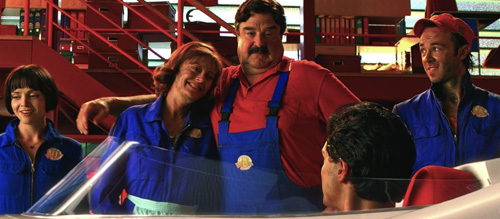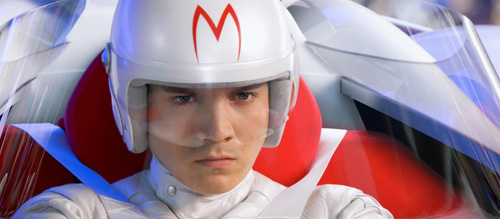‘Speed Racer’ at 15 – Review
Speed Racer (2008)
Directors: Lana Wachowski, Lilly Wachowski
Screenwriters: Lana Wachowski, Lilly Wachowski
Starring: Emile Hirsch, Christina Ricci, John Goodman, Susan Sarandon, Matthew Fox, Roger Allam, Paulie Litt, Rain, Yu Nan, Kick Gurry, John Benfield, Christian Oliver, Richard Rowntree, Hiroyuki Sanada, Benno Fürmann, Scott Porter
Following the massive financial success and pop culture dominance of The Matrix and its sequels between 1999 and 2003, writer-director siblings the Wachowskis could have gone anywhere next. What they eventually settled on was an adaptation of one of the first anime series to successfully cross over in the West. The response to Speed Racer was largely one of bewilderment, but a decade and a half on, what more can be gleaned from this ambitious living cartoon?
The ultimate embodiment of nominative determinism, Speed Racer (Emile Hirsch) dreams of becoming the greatest driver in ion-powered motorsport much to the disapproval of his family who are still grieving for the loss of his older brother Rex who died during a race ten years earlier. When shady conglomerate Royalton Industries offers Speed a generous contract to eliminate one of their competitors, he must decide between integrity and his family’s security, before long being drawn into a plot of industrial espionage, his drive to be as good as his brother leading him to question everything he knows about racing.
Yes this film is goofy, yes this film is corny, and that’s the point. There’s an endearing innocence to it all, from our protagonists’ blue-collar naivety and simplistic worldview to the fact that in this world they celebrate victory not with champagne but with cold milk. Our hero’s innate goodness is derided by the big baddie (Roger Allam, having fun being slimy) as “sickening schmaltz”, but that’s the film’s secret, that it’s just a straightforward, old-fashioned moral story driven by emotion and without a hint of irony.
It’s all about sticking to your principles and, much like the just-as-cartoony Fast and Furious franchise, sacrificing everything for family. However overwhelmed your senses might be after two-plus hours of blindingly colourful cartoon bludgeoning, the final ten minutes or so (helped in no small part by Michael Giacchino’s emotive, hummable score) may bring an unexpected tear to your eye.

Speed wouldn’t be who he is without his support network, girlfriend Trixie (Christina Ricci) and Mom and Pops Racer (Susan Sarandon and John Goodman), the latter of whom are great movie parents who are firm but fair and always fighting their family’s corner. Perhaps typically for most parents it’s down to the mother to actually say what needs to be said out loud: “There are times when you take my breath away… when your father is pretending he doesn’t have tears in his eyes”.
The film is never really aiming for any grounding in our reality and sometimes that’s OK. Our protagonist is named Speed Racer and he races, the investigating police officer is called Inspector Detector; this world clearly runs according to certain very literal rules. The opening shot of kaleidoscope colours sets the visual language used throughout the film, characters’ costumes colour-matching the sets, the vehicles, the mood of the scene, or all three at once.
In YouTube essayist Patrick H Willems’ video on film realism, he asks “Why do we care if movies are realistic?”. It’s a very good question. Why has this seemingly become the main thing for a director to shoot for? As Willems summarises, “realism” and “formalism” are at opposite ends of the cinema spectrum, with “classicism” (which incorporates the vast majority of films) sitting in the centre. He goes on to describe Speed Racer as “The most extreme example of formalism in mainstream American cinema in the 20th century”, and questions “How would realism improve this?… shouldn’t form follow function?”
The Wachowskis’ film is stratospherically over-the-top in its style, from the eye-popping action to the over-saturated colours and playing-to-the-back-row acting style. The action is described by the VFX team on the film’s Blu-ray features as “Car-fu”, a “Mix of NASCAR, hot wheels and skateboarding”. It’s understandable if a viewer might not gel with the overall effect, the slapstick and stylised imagery leaping off the screen, but that doesn’t make it bad filmmaking and it would be a disservice to the sheer creative energy that went into this to dismiss the film out of hand. Speed Racer has often been derided as a vacuous cartoon and as a gaudy video game (which unfairly uses “video game” as an insult, as a lesser art form), both criticisms that completely ignore what the film is trying to achieve.
One of the groups of baddies our heroes must go up against is an outfit of Dick Tracy-alike cartoon gangsters, the kind of guys who drive around in a heavily-armed 18-wheeler with a plush office that has one wall taken up by a piranha fish tank. Everything is dialled up to 11 and slapstick is king, the most memorable physical comedy moments being a ninja’s (“more like a none-ja, terrible what passes for a ninja these days”) car keys flying out of his pocket mid-fight, a brawl atop a mountain with anime-style freeze frames to accompany the prat-falls, and the really very silly duelling vehicles with gadgets ranging from buzz saws on mechanical arms to a pop-out beehive catapult.
It’s not our world, but nor is it a world that is entirely divorced from all credibility. Safety features were introduced by the in-universe motorsport teams after a horrible crash resulted in a fatality (the cockpits now seal the driver in a protective bubble and bounce them to safety if needed) and IP infringement and match-fixing are very prominent plot points.
While it may only just be undergoing critical reappraisal, as the Wachowskis’ first movie to be filmed in digital HD, Speed Racer employed “wraparound” location plates to construct the digital racetracks and environments which allowed for live compositing of CG elements with footage shot on the day, basically an early version of ILM’s much-touted Volume technology so extensively employed in TV shows like ‘The Mandalorian’.
This is probably the film from the 2000s trying the hardest to visually evoke another medium on film (in this case, Japanese anime). The only other prominent examples that commit as completely to their gimmick are what Ang Lee attempted with Hulk and Robert Rodriguez did with Sin City, both bringing comic book art to life and proving divisive in the process.
There’s no need at all for this to be 2 hrs 15, or for a film this visually striking to tell more than it shows (through such clunky dialogue), and not every performance does the job it should do (Speed and Trixie in particular have a tendency to be a little dull). Plus it’s very easy to overuse your comedy chimp sidekick. But the people who love Speed Racer really love it, so while the unique visuals can be too much for some, the uncomplicated emotion and the inventiveness required to achieve the Wachowskis’ vision is to be commended in a world of genre fare that often looks and feel exactly the same.
Score: 18/24
Recommended for you: Wachowski Movies Ranked


